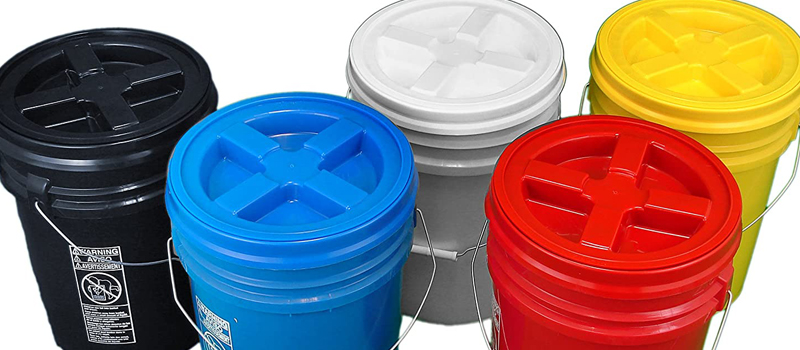You can’t go too far in talking about Food Storage before you hit or ‘kick’ a bucket. All puns aside, buckets are mighty handy when it comes to storing food. They are reliable, strong, light and can be moisture-free, and, when sealed, will keep most, if not all pests at bay. They are dime a dozen, readily available and the cost is low to acquire to boot.
Food Grade Buckets Please
The term “food grade” is often mentioned when the subject of long-term food storage. Barrels and buckets specifically, so what exactly does food grade mean? Here is the straight diddy from the US Food and Drug Administration (FDA):
The FDA requires that plastics used in food packaging be of greater purity than plastics used for non-food packaging. This is commonly referred to as food grade plastic. Food grade plastic does not contain dyes or recycled plastic deemed harmful to humans.
With that said, the plastic must not contain dyes or recycled plastic deemed harmful, that can be used for food, or drink. Additionally, the plastic container can no longer be considered food grade if it has been used to store non-food items like chemicals, paint, or detergent in any way.
So, in the interest in bringing you the full 411 on everything Backyard Farming, We got it from the big wigs (better known as the Society of Plastics Industry) a seven-point system that categorizes and labels the food grade plastics. Learning how to tell if a plastic container is food-grade plastic is easy. Each type is identified with a triangular-shaped label with rounded corners made of three arrows and a number in the center.
The various types are:
A-PET (or PETE): PET or PETE (polyethylene terephthalate) is a clear, tough polymer with exceptional gas and moisture barrier properties. PET’s ability to contain carbon dioxide (carbonation) makes it ideal for use in soft drink bottles. Examples: Soft drink bottles, detergent bottles.
B-HDPE: HDPE (high-density polyethylene) is used in milk, juice, and water containers in order to take advantage of its excellent protective barrier properties. Its chemical resistance properties also make it well suited for items such as containers for household chemicals and detergents. Most five gallon food buckets are made from HDPE. Examples: Milk bottles, shopping bags.
Most but not all food grade buckets are type 2 HDPE. But, and this is a big BUT, unless your HDPE bucket is specifically labeled as “food safe”, assume it is not. You can still use it if it is lined with a Mylar bag prior to use.
C-Vinyl (PVC): Vinyl (polyvinyl chloride or PVC) provides excellent clarity, puncture resistance and cling. As a film, vinyl can breathe just the right amount, making it ideal for packaging fresh meats that require oxygen to ensure a bright red surface while maintaining an acceptable shelf life. Examples: Plastic food wrap, shrink wrap, garden hoses, shoe soles.
D-LDPE: LDPE (low-density polyethylene) offers clarity and flexibility. It is used to make bottles that require flexibility. To take advantage of its strength and toughness in film form, it is used to produce grocery bags and garbage bags, shrink and stretch film, and coating for milk cartons. Examples: Squeeze bottles, dry cleaning bags.
E-PP: PP (polypropylene) has high tensile strength, making it ideal for use in caps and lids that have to hold tightly on to threaded openings. Because of its high melting point, polypropylene can be hot-filled with products designed to cool in bottles, including ketchup and syrup. It is also used for products that need to be incubated, such as yogurt.
F-PS: PS (polystyrene), in its crystalline form, is a colorless plastic that can be clear and hard. It can also be foamed to provide exceptional insulation properties. Foamed or expanded polystyrene (EPS) is used for products such as meat trays, egg cartons and coffee cups. It is also used for packaging and protecting appliances, electronics and other sensitive products.
G-Other: This category basically means “everything else” and is composed of plastics that were invented after 1987. Plastics labeled as grade 7 should be specifically noted as being “food safe” before they are used to package or handle food.
Okay, so now you got the definitions, how can we tell for sure what is and what is not food-grade? Here’s how you can be sure:
1. Purchase new buckets that are marked “food grade” by the manufacturer. In addition to the actual text, you can look for the marks “NSF”, “FDA” or “USDA Approved”.
2. Find free or low cost used buckets that you know have already been used to store food and haven’t been used for anything else. You can find these at bakeries, restaurants, and food processing plants. And if all else fails, a good portion of grocery stores also carry these types of buckets.
They usually come with handles, and in different colors. You can have them for a minimal fee from those places that are getting them and can’t get rid of them. If they are used from a place like a restaurant or a bakery and come with a previous aroma, try some baking soda or charcoal in the bucket and seal it up then rinse the bucket and take another sniff.
Standard Lids Versus Gamma Seal Lids
Way back when there was only one form that the buckets came in, and those lids that took a miracle and a lot of elbow grease to get open. In fact, I know for many of the old-timers who did food storage, absolutely hated them. But, they were a necessary tool of the trade along with the crank wrench it took to open it. Fortunately, most 5 and 6-gallon buckets nowadays utilize more and more the Gamma Seal Lids with a universal 12” opening. This means that the various lids are now easily interchangeable. The important thing to look for is a lid with a rubber gasket fitted to its inside rim. With the gasket in place, the lid, when securely attached to the bucket, forms a nice seal.
When you need to get something out of your Gamma-sealed bucket, all you need to do is unscrew the inner lid, pull out your product, then screw the lid back down.
Tip: Applying a light coat of petroleum jelly, Crisco, or other lubricants on the lip can keep the rubber gasket supple and helps to avoid tears in the rubber. This will also contribute to a good seal.
Think of the Gamma seal as a giant screw top for your bucket. All you need to do is snap the outer adapter ring onto the bucket then screw the inner lid into the outer ring. To make it easy, the Gamma lid has a big “X” molded in plastic making it easy to grab onto and spin.
Here are some more advantages of the Gamma Seal Lids:
The Gamma Seal Lid has a stacking channel that is built into the outside rim. This allows you to safely stack several sealed buckets on top of each other, saving space.
They can be re-sealed over and over again.
The bugs cannot get in (although your product has to be bug and insect free to begin with).
The Gamma Seal Lids can be purchased in various colors if your storage system uses color-coding.
What About Mylar Bags and Buckets?
When using buckets and lids, an inner bag is recommended but is not mandatory, especially if you are using the bucket for short-term storage to keep out moisture and insects. An example would be the short-term storage of dog food.
Using a double seal system can ensure that the food that you are putting away for the time, stays clear of contaminants. In practical use, you can use a vacuum seal plastic bag or a one-gallon Mylar bag. Either way, also use a 300 cc oxygen absorber and seal up the bucket. When it comes time to use some of the products, just take off the gamma seal lid, remove a single bag of food, screw on the gamma lid, and it’s all good until the next time.
I recommend, mostly for practical purposes, is to color coordinate with the Gamma Seal Lids the type of food you have in each bucket. Red for wheat, green for oats, and so on. This way you can stay organized without really thinking about it. This is ideal if you need to get out in a hurry or if you want to share some of your product with a loved one.
Overall TakeAway
What do you do next? Head out to Wal-Mart, Costco, the LDS Home Storage Center, or your favorite bulk food supplier and start purchasing 25 or 50-pound bags of dried beans, rice, pasta, oats, sugar, salt, favorite spices, and other foods that you know your family will eat.
As always, do your best to purchase a little bit extra with each shopping trip or with each paycheck. It may not seem like much but trust me, your emergency food supply will grow quickly and you will begin to feel confident that you will have plenty of food to eat during hard times or following a major disruptive event.






